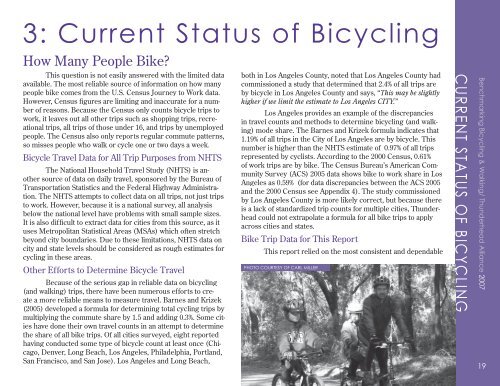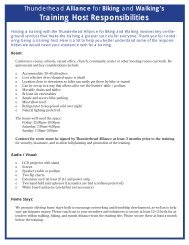2007 Benchmarking Report - Alliance for Biking & Walking
2007 Benchmarking Report - Alliance for Biking & Walking
2007 Benchmarking Report - Alliance for Biking & Walking
You also want an ePaper? Increase the reach of your titles
YUMPU automatically turns print PDFs into web optimized ePapers that Google loves.
3: Current Status of Bicycling<br />
How Many People Bike<br />
This question is not easily answered with the limited data<br />
available. The most reliable source of in<strong>for</strong>mation on how many<br />
people bike comes from the U.S. Census Journey to Work data.<br />
However, Census figures are limiting and inaccurate <strong>for</strong> a number<br />
of reasons. Because the Census only counts bicycle trips to<br />
work, it leaves out all other trips such as shopping trips, recreational<br />
trips, all trips of those under 16, and trips by unemployed<br />
people. The Census also only reports regular commute patterns,<br />
so misses people who walk or cycle one or two days a week.<br />
Bicycle Travel Data <strong>for</strong> All Trip Purposes from NHTS<br />
The National Household Travel Study (NHTS) is another<br />
source of data on daily travel, sponsored by the Bureau of<br />
Transportation Statistics and the Federal Highway Administration.<br />
The NHTS attempts to collect data on all trips, not just trips<br />
to work. However, because it is a national survey, all analysis<br />
below the national level have problems with small sample sizes.<br />
It is also difficult to extract data <strong>for</strong> cities from this source, as it<br />
uses Metropolitan Statistical Areas (MSAs) which often stretch<br />
beyond city boundaries. Due to these limitations, NHTS data on<br />
city and state levels should be considered as rough estimates <strong>for</strong><br />
cycling in these areas.<br />
Other Ef<strong>for</strong>ts to Determine Bicycle Travel<br />
Because of the serious gap in reliable data on bicycling<br />
(and walking) trips, there have been numerous ef<strong>for</strong>ts to create<br />
a more reliable means to measure travel. Barnes and Krizek<br />
(2005) developed a <strong>for</strong>mula <strong>for</strong> determining total cycling trips by<br />
multiplying the commute share by 1.5 and adding 0.3%. Some cities<br />
have done their own travel counts in an attempt to determine<br />
the share of all bike trips. Of all cities surveyed, eight reported<br />
having conducted some type of bicycle count at least once (Chicago,<br />
Denver, Long Beach, Los Angeles, Philadelphia, Portland,<br />
San Francisco, and San Jose). Los Angeles and Long Beach,<br />
both in Los Angeles County, noted that Los Angeles County had<br />
commissioned a study that determined that 2.4% of all trips are<br />
by bicycle in Los Angeles County and says, “This may be slightly<br />
higher if we limit the estimate to Los Angeles CITY.”<br />
Los Angeles provides an example of the discrepancies<br />
in travel counts and methods to determine bicycling (and walking)<br />
mode share. The Barnes and Krizek <strong>for</strong>mula indicates that<br />
1.19% of all trips in the City of Los Angeles are by bicycle. This<br />
number is higher than the NHTS estimate of 0.97% of all trips<br />
represented by cyclists. According to the 2000 Census, 0.61%<br />
of work trips are by bike. The Census Bureau’s American Community<br />
Survey (ACS) 2005 data shows bike to work share in Los<br />
Angeles as 0.59% (<strong>for</strong> data discrepancies between the ACS 2005<br />
and the 2000 Census see Appendix 4). The study commissioned<br />
by Los Angeles County is more likely correct, but because there<br />
is a lack of standardized trip counts <strong>for</strong> multiple cities, Thunderhead<br />
could not extrapolate a <strong>for</strong>mula <strong>for</strong> all bike trips to apply<br />
across cities and states.<br />
Bike Trip Data <strong>for</strong> This <strong>Report</strong><br />
This report relied on the most consistent and dependable<br />
PHOTO COURTESY OF CARL MILLER<br />
CURRENT STATUS OF BICYCLING<br />
<strong>Benchmarking</strong> Bicycling Bicycling & <strong>Walking</strong> & <strong>Walking</strong>/ the U.S./ Thunderhead <strong>Alliance</strong> <strong>2007</strong> <strong>2007</strong><br />
19 19



